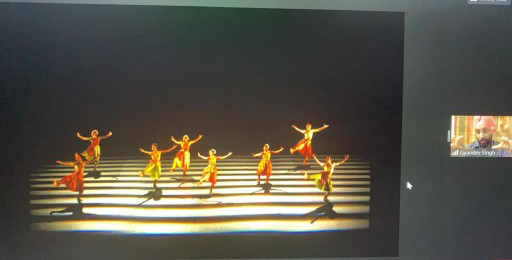
“In the right light, at the right time, everything is extraordinary,” said Aaron Rose.
Listening to Gyandev Singh’s hour-long lecture on his exploration and experience of engaging with Bharatanatyam productions and lighting them, for the Dance India Asia Pacific was the opportunity to appreciate how lighting becomes a “co-creator of sorts with the dancer on stage”. “Lighting has the amazing ability to augment and hold space for the dancer and allow her/him to create and express herself/himself in a way that the entire viewing experience is enhanced.”
Growing up in Chandigarh, Gyandev began by admitting that he didn’t grow up watching Bharatanatyam. “Perhaps my first exposure to Bharatanatyam that I remember vividly was a performance that I watched of Leela Samson,” he said, “I remember my parents took me for the performance and I still recall being absolutely mesmerised by what I saw. I loved how Leela Akka imagined so many objects and characters and I was completely taken in by how she held the audience’s attention there, all alone on stage with only lighting on her face, and create these beautiful images allowing us peek into her imagination.”A graduate of the National School of Drama (NSD), Gyandev’s tryst with the world of Bharatanatyam was piqued by his own curiosity of the idea of abstraction of the very nature of Bharatanatyam itself. “My constant pursuit has been to see how I can create design contexts wherein the lighting doesn’t merely illuminate the dancer/s but also is able to create a standalone narrative of its own on stage. I like the whole idea of using the stage floor to create a pattern on stage. I also continue to be fascinated by the geometry of the bodies, the lines they can create and I’m always trying to see how I can use my lighting to create a third eye.”

Gynadev allowed his audiences insights into his journey and pursuit in the world of lighting through a series of examples from productions he has been a part of!
Anjaneyam: Hanuman’s Ramayana by Apsaras Arts
Hailed a visual treat, Gyandev talked about how he gleaned concepts from musicals to create for this mammoth productions a sonography. “I also conceptualised the idea of using projection mapping to create scenes and sceneries that looked like magical, painted backdrops,” he said.
Disha: Spanda
What happens when geometry and architecture decide to have a conversation with each other? Gyandev referred to Spanda’s Disha, a production where he used lighting to have a voice of its own, lighting dancers but also using the stage floor to weave interesting patterns on stage and for the audience to understand the interplay of lighting itself. “I’m also very intrigued by the idea of using lighting breaking up the body into parts and to see how each of these parts respond to lighting.”
Gyandev also talked about his experiences with Thari by Malavika Sarukkai and spoke about how Malavika Sarukkai involved and included him right from the beginning of the production. “That way you understand it, in-depth from the start and start thinking about it collaboratively,” said Gyandev. He also shared excerpts from Mara by Mythili Prakash, Agathi by Apsaras Arts and The Tiger and the Bull by Ananda Shankar Jayanth. In Agathi for instance, he said Gynadev talked of how the lighting in itself became a sutradhar of sorts directing the viewer’s eye to the story. He shared a powerful scene — the boat sequence — where the lighting itself creates a pattern of a boat on stage.
Here’s an excerpt:
Equally powerful was a scene Gyandev shared from Parama Padam by Mohanapriyan Thavarajah of Apsaras Arts to demonstrate how “light and dance can play with each other”.

Followed by an interesting Q & A, this session was moderated by Vidhya Nair of Apsaras Arts! Up next Appreciation of Music and Poetry for Dance by Sujatha Vijayaraghavan









